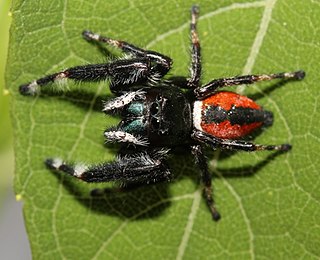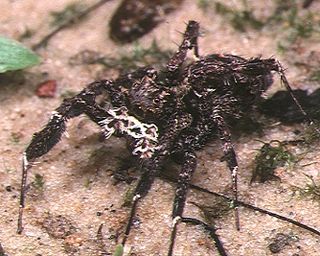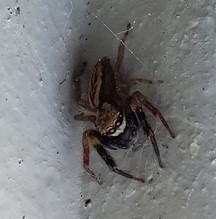
Jumping spiders are a group of spiders that constitute the family Salticidae. As of 2019, this family contained over 600 described genera and over 6,000 described species, making it the largest family of spiders at 13% of all species. Jumping spiders have some of the best vision among arthropods and use it in courtship, hunting, and navigation. Although they normally move unobtrusively and fairly slowly, most species are capable of very agile jumps, notably when hunting, but sometimes in response to sudden threats or crossing long gaps. Both their book lungs and tracheal system are well-developed, and they use both systems. Jumping spiders are generally recognized by their eye pattern. All jumping spiders have four pairs of eyes, with the anterior median pair being particularly large.

A bolas spider is a member of the orb-weaver spider that, instead of spinning a typical orb web, hunts by using one or more sticky "capture blobs" on the end of a silk line, known as a "bolas". By swinging the bolas at flying male moths or moth flies nearby, the spider may snag its prey rather like a fisherman snagging a fish on a hook. Because of this, they are also called angling or fishing spiders. The prey is lured to the spider by the production of up to three sex pheromone-analogues.

Portia labiata is a jumping spider found in Sri Lanka, India, southern China, Burma (Myanmar), Malaysia, Singapore, Java, Sumatra and the Philippines. In this medium-sized jumping spider, the front part is orange-brown and the back part is brownish. The conspicuous main eyes provide vision more acute than a cat's during the day and 10 times more acute than a dragonfly's, and this is essential in P. labiata′s navigation, hunting and mating.

Ascyltus are a genus of jumping spiders in the family Salticidae that was first described by Ferdinand Anton Franz Karsch in 1878. As of December 2020, the genus contained 10 species. Ascyltus spiders utilize their vision in courtship, hunting, and navigation. They are typically large to medium-sized salticids and often move relatively slowly. However, they are capable of agile jumps when moving, hunting, or to avoid predators. They have well developed book lungs and tracheal systems, and they are capable of utilizing both systems. Ascyltus have four pairs of eyes, with the anterior median pair being the most prominent. One distinguishable characteristic of the genus is their antero-lateral carapace, which is iridescently coloured.

Phaeacius is a spider genus of the family Salticidae, found in sub-tropical China and between India and the Malay Peninsula, including Sri Lanka, Sumatra and the Philippines. Although other spiders can jump, salticids including Phaeacius have significantly better vision than other spiders, and their main eyes are more acute in daylight than a cat's and 10 times more acute than a dragonfly's. The main eyes focus accurately on an object at distances from approximately 2 centimetres (0.79 in) to infinity, and in practice can see up to about 75 centimetres (30 in). They do not spin webs.

Porrhothele antipodiana, the black tunnelweb spider, is a species of mygalomorph spider that lives in New Zealand. It is the most common and widespread of several species in the genus Porrhothele, and is especially common in the greater Wellington region where the vagrant mature males are often encountered in or around dwellings. This species is one of New Zealand's most studied spiders. In New Zealand, the common name "tunnelweb spider" is also often used to refer to members of the genus Hexathele. Neither should be confused with their distant relatives, the highly venomous Australian funnel-web spiders.

Argiope protensa, commonly known as the tailed grass spider or teardrop spider, is a species of spider in the orb weaver family, Araneidae. This species is fairly common and widespread in Australasia, but like many spider species, little is known of its ecology, biology, or life history.

Maevia inclemens or the dimorphic jumping spider is a relatively common and colorful jumping spider of North America. In the males there are two forms, a very rare phenomenon in zoology. These use different courting displays, and differ in appearance: the "tufted" morph has a black body and pedipalps ("palps"), three black tufts across its "head", and pale legs; and the "gray" morph has black and white stripes all over its body and legs, orange palps, and no tufts. However, each form accounts for 50% of the adult males, and they are equally successful in mating. A female of Maevia inclemens is 6.5 to 8.0 millimetres long, while males are 4.75 to 6.50 millimetres long.

Trite planiceps, commonly known as the black-headed jumping spider, is a common jumping spider (Salticidae) endemic to New Zealand and one of about 150 species of jumping spiders in New Zealand.

Zygoballus sexpunctatus is a species of jumping spider which occurs in the southeastern United States where it can be found in a variety of grassy habitats. Adult spiders measure between 3 and 4.5 mm in length. The cephalothorax and abdomen are bronze to black in color, with reddish brown or yellowish legs. The male has distinctive enlarged chelicerae and front femora. Like many jumping spiders, Z. sexpunctatus males exhibit ritualized courtship and agonistic behavior.

Plexippus paykulli is a species of jumping spider. It is native to south east Asia but has spread to other parts of the world and globe. In the United States it is called the pantropical jumping spider. It is usually associated with buildings and may be found near light sources catching insects attracted by the light. It is named in honor of Gustaf von Paykull.

Anasaitis canosus, previously of the genus Corythalia, is a small jumping spider that can typically be found atop leaf-litter or man-made structures such as fences and exterior walls. This species is more commonly known as the twin-flagged jumping spider due to the two pennant shaped markings on the dorsal side of the cephalothorax. Typical of the genus Anasaitis, this species has iridescent setae ("scales") which may appear white, green or pink which create the "flags" as well as patches on the male pedipalps used in courtship and intraspecific signaling. This species is roughly 5 to 6 mm in length. A. canosus ranges from Mexico to South Carolina along the Gulf of Mexico.

Phidippus clarus, also known as the brilliant jumping spider, is a species of jumping spider found in old fields throughout eastern North America. It often waits upside down near the top of a plant, which may be useful for detecting prey, and then quickly jumps down before the prey can escape. The spider is one of 60 species in the genus Phidippus, and one of about 5,000 in the Salticidae, a family that accounts for about 10% of all spider species. P. clarus is a predator, mostly consuming insects, other spiders, and other terrestrial arthropods.

Carrhotus xanthogramma is a species of jumping spider belonging to the family Salticidae.

Portia fimbriata, sometimes called the fringed jumping spider, is a jumping spider found in Australia and Southeast Asia. Adult females have bodies 6.8 to 10.5 millimetres long, while those of adult males are 5.2 to 6.5 millimetres long. Both sexes have a generally dark brown carapace, reddish brown chelicerae ("fangs"), a brown underside, dark brown palps with white hairs, and dark brown abdomens with white spots on the upper side. Both sexes have fine, faint markings and soft fringes of hair, and the legs are spindly and fringed. However, specimens from New Guinea and Indonesia have orange-brown carapaces and yellowish abdomens. In all species of the genus Portia, the abdomen distends when the spider is well fed or producing eggs.

Portia schultzi is a species of jumping spider which ranges from South Africa in the south to Kenya in the north, and also is found in West Africa and Madagascar. In this species, which is slightly smaller than some other species of the genus Portia, the bodies of females are 5 to 7 mm long, while those of males are 4 to 6 mm long. The carapaces of both sexes are orange-brown with dark brown mottling, and covered with dark brown and whitish hairs lying over the surface. Males have white tufts on their thoraces and a broad white band above the bases of the legs, and these features are less conspicuous in females. Both sexes have tufts of orange to dark orange above the eyes, which are fringed with pale orange hairs. Males' abdomens are yellow-orange to orange-brown with blackish mottling, and on the upper sides are black and light orange hairs, and nine white tufts. Those of females are pale yellow and have black markings with scattered white and orange-brown hairs on the upper side. P. schultzi has relatively longer legs than other Portia, and a "lolloping" gait.

Pseudicius adustus is a species of jumping spider in the genus Pseudicius that is endemic to Namibia. The spider was first defined in 2016 by Wanda Wesołowska. The spider is small, with an oval carapace typically 1.8 mm (0.07 in) long and an abdomen 2.6 mm (0.10 in) long. The abdomen is elongated like other members of the genus, but with a yellowish with a pattern of eight brown patches. The female has an ovoid epigyne that has a large deep central depression and short wide insemination ducts. The design of the epigyne helps distinguish it from related species, like Pseudicius solitarius, which has larger receptacles and longer insemination ducts. It can also be most identified by the pattern on its abdomen. The male has not been described.

Pseudicius athleta is a species of jumping spider in the genus Pseudicius that is found in Kenya and Uganda. The spider was first defined in 2011 by Wanda Wesołowska. It lives communally, in individual nests which may contain either male or female spiders, which engage in complex courtship rituals. The spider is small, with an elongated cephalothorax between 1.8 and 2.2 mm long and an abdomen between 2.2 and 2.8 mm long. The carapace is dark brown with a black eye field but the abdomen has a pattern that differs between the male, which is marked by a brownish-fawn streak, and the female, which has a complex pattern consisting of a herring-bone pattern on the top, diagonal patches on the edge and two small round white spots on the bottom. Pseudicius athleta can be differentiated from other species in the genus by its copulatory organs. The male has a long thin embolus and characteristic tibial apophysis, which has three prongs. The female has narrow tube-like spermathecae. However, it is the swollen first leg, which is reminiscent of the large muscle of an athlete, as reflected in the species name, that most easily identifies the species.

Maratus griseus, the white-banded house jumping spider, is a species of jumping spider in the family Salticidae. It is found in Australia and New Zealand.

Salsa fuliginata, commonly known as the sooty orbweaver, is a orb-weaver spider of Araneidae in the genus Salsa. The species is found throughout southeastern Australia and New Zealand.





















